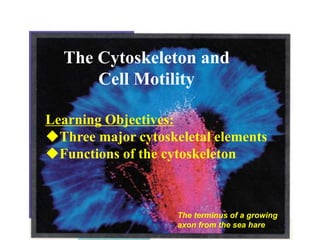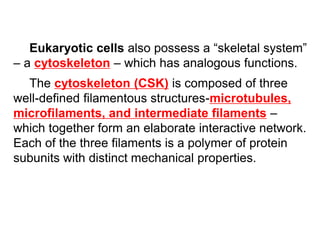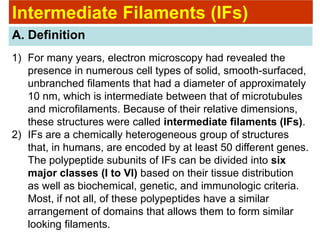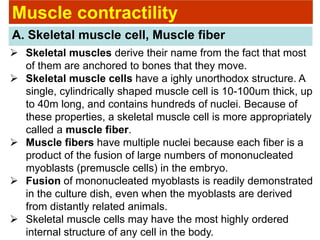cytoskeleton.pptx
- 1. The Cytoskeleton and Cell Motility Learning Objectives: Three major cytoskeletal elements Functions of the cytoskeleton The terminus of a growing axon from the sea hare
- 2. Eukaryotic cells also possess a “skeletal system” – a cytoskeleton – which has analogous functions. The cytoskeleton (CSK) is composed of three well-defined filamentous structures-microtubules, microfilaments, and intermediate filaments – which together form an elaborate interactive network. Each of the three filaments is a polymer of protein subunits with distinct mechanical properties.
- 3. The cytoskeleton is a cellular scaffolding or “skeleton system” contained within cytoplasm. Microtubule Microfilament Intermediate filament 8.1 Overview of the cytoskeleton
- 4. Microfilaments are solid, thinner structures composed of the globular proteins- actin. Microtubule are rigid tubes composed of subunits of the globular protein- tubulin. Intermediate filament are tough, ropelike fibers composed of a variety of related proteins. Although the components of the cytoskeleton appear stationary in micrographs, in reality they are highly dynamic structures capable of rapid and dramatic reorganization. We will consider each of the three major cytoskeletal elements separately in this chapter, after we briefly survey their major activities. Contents of cytoskeleton
- 5. Microfilaments, also called actin filaments, located throughout the cells. Microtubules are straight, hollow cylinders that are located inside the cytoplasm of the cell. IFs are the most abundant and stable components of the cytoskeleton. Most types of IFs are cytoplasmic, but one type, the lamins, are nuclear.
- 6. Key to cytoskeletal functions microvilli Motile machinery Mitotic spindle
- 7. A dynamic scaffold providing structural support that can determine the shape of the cell and resist forces that tend to deform it. The flat, rounded shape of many cultured cells, for example, dependents on a radial array of microtubules in the cell’s cytoplasm. An internal framework responsible for positioning the various organelles within the interior of the cell. This function is particularly evident in polarized epithelial cells, in which organelles are arranged in a defined pattern along an axis from the apical to the basal end of the cell. Major functions of cytoskeleton
- 8. A network of highways that direct the movement of materials and organelles with cells. Examples of this function include the delivery of mRNA molecules to specific parts of a cell, the movement of membranous carriers from the endoplasmic reticulum to the Golgi complex, and the transport of vesicles containing neurotransmitters down the length of a nerve cell. The force generating apparatus that moves cells from one place to another. Single-celled organisms move either by “crawling” over the surface of a solid substratum or by propelling themselves through their aqueous environment with the aid of specialized locomotor organelles (cilia and flagella). Multicellular animals have a variety of cells that are capable of independent locomotion. Major functions of cytoskeleton
- 9. A site for anchoring mRNAs and facilitating their translation into polypeptides. For example, it was found that the poly (A) mRNA molecule is localized between the actin filaments in human fibroblasts. An essential component of the cell’s division machinery. Cytoskeletal elements make up the apparatus responsible for separating the chromosomes during mitosis and meiosis and for splitting the parent cell into two daughter cells during cytokinesis. These events are discussed at length in further Chapter. Major functions of cytoskeleton
- 10. An example of the role of microtubules in transporting organelles. The peroxisomes were shown in green; Microtubules appear red.
- 11. The cytoskeletion is currently one of the most actively studied subjects in cell biology. The development of techniques allow investigators to pursue a coordinated morphological, biochemical, and molecular approach. A few of the most important approaches to the study of the cytoskeleton will be briefly introduced. The study of cytoskeleton
- 12. The use of genetically engineered cells Knockout animals: most often mice that lack a particular gene. Over express model: usually the gene of a target protein with a dominant negative mutant is transfected and high expressed. GFP cells and animals: GFP is fused with target proteins and then induced to express stably in a cell line or in a whole body. The study of cytoskeleton
- 13. The study of cytoskeleton Expression of a mutant motor protein inhibits the dispersion of pigment granules in a pigment cells.
- 14. Microfilament (MF) A. MFs are made of actin and involved in cell motility Using ATP, G-actin polymerizes to form MF, or F-actin 8 nm in diameter and composed of globular subunits of the protein actin (G-actin)
- 15. Actin filament structure. a, a model of an actin filament. The actin subunits are represented in three colors to distinguish the consecutive filament. The subdomains in one of the actin subunits are labeled 1, 2, 3, and 4. b, EM of a replica of an actin filament showing its double-helical architecture. Actin was identified more than 50 years ago: Major contractile proteins in muscle cells. Major protein in every of eukaryotic cell. Higher plant and animal species possess a number of actin genes.
- 16. B. MF assembly and disassembly Characteristics: (1) Within a MF, all the actin monomers are oriented in the same direction, so MF has a polarity
- 17. (2) In vitro, (Polymerization) both ends of the MF grow, but the plus end faster than the minus. Because actin monomers tend to add to a filament’s plus end and leave from its minus end---- “Tread-milling” Cc=0.1umol/L,Mg2+,K+,Na+ ─ +
- 18. (3) Dynamic equilibrium between the G-actin and polymeric forms, which is regulated by ATP hydrolysis and G-actin concentration. Actin is an ATPase.
- 19. (4) Dynamic equilibrium is required for the cell functions. Some MFs are temporary and others permanent. Microvilli Motile machinery Contractile ring Stress fiber
- 20. (5)The nucleation of actin filaments at the plasma membrane is frequently regulated by external signals, allowing the cell to change its shape and stiffness rapidly in response to changes in its external environment. This nucleation is catalyzed by a complex of proteins that includes two actin-related proteins, or ARPs(Arp2 and Arp3).
- 21. C. Myosin: the molecular motor for actin filaments (1) Myosin move toward the plus ends of microfilaments.
- 22. (2) Conventional (Type II) myosins: the best understood type of myosins. A pair of globular heads: ATPase A pair of necks: α helix and 2 light chains A single, long, rod-shaped tail
- 23. Motor activity of myosin: Isolated myosin heads (S1 fragment) that was immobilized on the surface of a glass coverslip are capable of sliding attached actin filaments. In vitro motility assay for myosin: (a) Schematic drawing (b) Results of the experiment depicted in (a). Two video images were taken 1.5sec apart. The dashed lines with arrow heads show the movement of the F-actin.
- 24. Bipolar myosin II filament: Myosin molecules assemble so that the ends of the tails point toward the center of the filament and the globular heads point away from the center. Dimers Tetramer Hexamer Octamer
- 25. (3) Unconventional myosins: at least 14 different classes (type I and type III-XV), 2 of which are unique to plants. Myosin I: (a) Four light chains; (b) Two are calmodulin; (c) The head binds to an F-actin; (d) The tail is thought to bind to plasma membrane.
- 26. Microtubules (MTs) A. Structure and Composition MTs are hollow, tubular structure. They occur in nearly every eukaryotic cells. MTs are basic components of diverse array of structure, including spindle, cilia and flagella. MTs have an outer diameter of 24 nm, a wall thickness of ~5 nm, and may extend across the length or breadth of a cell. The wall of a MT is composed of globular proteins (tubulins) arranged in longitudinal rows, termed protofilaments. MTs are consisted of 13 protofilaments arrayed in a circular pattern within the wall, when viewed in cross section. (a) EM of MTs in longitudinal view; (b) EM of MTs in cross section; (c) A ribbon model showing the 3D structure of the αβ-tubulins heterodimer. (d) Schimetic diagram
- 27. B. Assembly and Characteristics of MTs (1) Each protofilament is assembled from dimeric building blocks consisting of one α-tubulin and one β-tubulin. (2) The two types of tubulin subunits have a similar three- dimensional structure and fit tightly together. (3) The tubulin dimers are organized in a linear array along the length of each protofilament. (4) The protofilament is asymmetric with an α-tubulin at one end and a β-tubulin at the other end. (5) All of the protofilaments of a MTs have the same polarity, and results in the entire polymer has polarity. (6) One end of a MT is known as the plus end, the other as the minus end. The endmost row of subunits at he plus end of MT are β-tubulin, whereas subunits at the tip of the minus end are α-tubulin.
- 28. Dynamic instability due to the structural differences between a growing and a shrinking microtubule end. GTP cap; Catastrophe: accidental loss of GTP cap; Rescue: regain of GTP cap
- 29. C. MT Associated Proteins, MAPs (1) Most of the MAPs are found only in brain tissue, but one of these proteins, called MAP4, has a wide distribution. (2) MAPs typically have one domain that attaches to the side of a MT and another domain that extends outward. Schematic diagram of a MAP2 bound to the surface of a MT. Each MAP2 contains 3 tubulin binding sites connected by short arm. The binding sites are spaced at sufficient distance to allow the MAP2 to attach to three separate tubulin subunits in the wall of the MT. The tails of the MAP project outward, allowing them to interact with other components.
- 30. D. MTs primarily act as structural supports and organizers (1) MTs are stiff enough to resist forces that might compress or bend the fiber. The distribution of cytoplasmic MTs in a cells helps determine the shape of that cell.
- 31. (2) MTs play a key role in maintaining the extended shape of the axon as it slowly grows out of the central nervous system into the peripheral embryonic tissues.
- 32. MTs as supporting rods: (a) This protist has tentacles projecting from its cell body. (b) The tentacles are supported by an elaborate spiral array of MTs.
- 33. (3) In plant cells, MTs play an indirect role in maintaining cell shape through their influence on the formation of the cell wall. To influence the movement of cellulose-synthesizing enzymes located in the plasma membrane. To determine the orientation of these cellulose microfibrils. (3) MTs are also thought to play a role in maintaining the internal organization of cells, for example, the location of membrane organelles, particularly the Golgi complex.
- 34. E. MTs as Agents of Intracellular Motility (1) Axonal Transport (a) Schematic drawing of a nerve cell showing the movement of vesicles down the length of an axon along tracks of MTs. (b) Schematic drawing of the organization of the MTs and intermediate filaments within an axon.
- 35. F. Motor Proteins That Traverse the MTs (1) Kinesins: (a) structure of a kinesin molecule; (b) schematic diagram of a kinesin moving a vesicle along a MT track. (c) the conformational changes of the head and neck portions of kinesin that drive the movement of the protein along a MT. To convert chemical energy into mechanical energy, to move cellular cargo attached.
- 36. Kinesin mediated organelle transport: (a,c) cell’s mitochondria are located along MTs; (b,d) lack of kinesin protein caused that the Mit clustered in the central region of the cell.
- 37. (2) Cytoplasmic Dynein: Dynein is the first microtubule-associated motor protein, which was discovered in 1963 as the protein responsible for the movement of cilia and flagella. The cytoplasmic dynein was purified and characterized from mammalian brain tissue, and was soon identified in a variety of nonneural cells. It is now known to be a ubiquitous motor protein in eukaryotic cells. Cytoplasmic dynein is a huge protein composed of two identical heavy chains (acts a force-generating engine) and a variety of intermediate and light chains. Cytoplasmic dynein moves along a microtubule toward the polymer’s minus end. Two roles for cytoplasmic dynein: 1) A force generating agent in the positioning of the spindle and movement of chromosomes during mitosis. 2) A minus end-directed microtubular motor for the positioning of the Golgi complex and the movement of vesicles and organelles through the cytoplasm.
- 38. (2) Cytoplasmic Dynein: (a) structure of dynein; (b) two vesicles moving in opposite directions along the same MT; (c) kinesin mediated and dynein mediated transport of vesicles.
- 39. G. Microtubule organizing centers, MTOCs (1) Two phases of MT assembly: a slower phase of nucleation, in which a small portion of the MT is initially formed, and a more rapid phase of elongation. (2) Microtubule organizing centers: The nucleation of MT in vivo is associated with a variety of specialized structures that, because of their role in MT nucleation and organization, are called MTOCs. Major types of MTOCs: Centrosomes: the sites of the MT nucleation in animal cells. MTs typically form in association with the centrosome, a complex structure that contains two centrioles and surrounded pericentriolar material (PCM). Basal bodies: MTs in a cilium or flagellum originate from a structure called a basal body. Other MTOCs: in plant cells, MTOC consists of patches of material situated at the outer surface of the nuclear envelop.
- 40. Structure of the centrosome: paired centroles and the surrounding pericentriolar materials (PCM), where nucleation occurs
- 41. H. The dynamic properties of Microtubules The dynamic character of the MT cytoskeleton is well illustrated by plant cells. If a typical plant cell is followed from one mitotic division to the next, four distinct arrays of MTs appear, one after another.
- 42. 1) During most of interphase, the MTs of a plant cell are distributed widely throughout the cortex. 2) As the cell approaches mitosis, the MTs disappear from most of the cortex, leaving only a single transverse band, called the preprophase band. 3) As the cell progresses into mitosis, the preprophase band is lost and MTs reappear in the form of the mitotic spindle. 4) After the chromosomes have been separated, the mitotic spindle disappears and is replaced by a bundle of MTs called the phragmoplast, which plays a role in the formation of the cell wall that separates the two daughter cells.
- 43. I. Cilia and Flagella: structure and function Cilia and Flagella are hairlike, motile organelles that project formt eh surface of a variety of eukaryotic cells. Cilia and flagella are two versions of the same structure and are best distinguished by their patterns of movement. Cilia tend to occur in large numbers on the cell surface, and their beating activity is usually coordinated. Flagella are usually longer than cilia, and cells have fewer of them. Flagella exhibit a variety of different beating patterns.
- 44. Intermediate Filaments (IFs) A. Definition 1) For many years, electron microscopy had revealed the presence in numerous cell types of solid, smooth-surfaced, unbranched filaments that had a diameter of approximately 10 nm, which is intermediate between that of microtubules and microfilaments. Because of their relative dimensions, these structures were called intermediate filaments (IFs). 2) IFs are a chemically heterogeneous group of structures that, in humans, are encoded by at least 50 different genes. The polypeptide subunits of IFs can be divided into six major classes (I to VI) based on their tissue distribution as well as biochemical, genetic, and immunologic criteria. Most, if not all, of these polypeptides have a similar arrangement of domains that allows them to form similar looking filaments.
- 45. B. IF assembly and disassembly The basic unit of IF assembly is thought to be a tetramer formed by two dimers that become aligned side-by side in a staggered fashion with their N- and C- termini pointing in opposite (antiparallel) directions. Tetramers associated with one another both side to side and end to end to form the final filament. IFs are highly resistant to tensile forces, and tend to be more resistant to chemical disruption than other types of cytoskeletal elements and more difficult to solubilize. IFs can be depolymerized and repolymerized repeatedly in vitro, indicating that the subunits possess all of the information necessary for their self-assembly.
- 46. C. Types and Functions of IFs
- 47. Function of IFs: Confer mechanical strength on tissues Disruption of keratin networks causes blistering
- 48. Muscle contractility A. Skeletal muscle cell, Muscle fiber Skeletal muscles derive their name from the fact that most of them are anchored to bones that they move. Skeletal muscle cells have a ighly unorthodox structure. A single, cylindrically shaped muscle cell is 10-100um thick, up to 40m long, and contains hundreds of nuclei. Because of these properties, a skeletal muscle cell is more appropriately called a muscle fiber. Muscle fibers have multiple nuclei because each fiber is a product of the fusion of large numbers of mononucleated myoblasts (premuscle cells) in the embryo. Fusion of mononucleated myoblasts is readily demonstrated in the culture dish, even when the myoblasts are derived from distantly related animals. Skeletal muscle cells may have the most highly ordered internal structure of any cell in the body.
- 49. The structure of skeletal muscle
- 51. B. The Sliding Filament Model of Muscle contraction All skeletal muscles operate by shortening. The units of shortening are the sarcomeres, whose combined decrease in length accounts for the decrease in length of the entire muscle. The banding pattern of the sarcomeres at different stages in the contractile process evidenced the mechanism underlying muscle contraction. A band remained in length, while H band and I bands decreased in width and then disappeared altogether. As shortening progressed, the Z lines on both ends of the sarcomere moved inward until they contacted the outer edges of the A band.
- 52. The shortening of the sarcomere during muscle contraction
- 53. Tropomyosin, Tm and Tropnin, Tn Ropelike molecule Regulate MF to bind to the head of myosin Complex, Ca2+-subunit Control the position of Tm on the surface of MF
- 54. Summary of cytoskeleton 1. Three types of cytoskeletal filaments are common to many eucaryotic cells and are fundamental to the spatial organization of these cells. 2. The set of accessory proteins is essential for the controlled assembly of the cytoskeletal filaments(includes the motor proteins: myosins, dynein and kinesin) 3. Cytoskeletal systems are dynamic and adaptable. Nucleation is rate-limiting step in the formation of a cytoskeletal polymer. 2. Regulation of the dynamic behavior and assembly of the cytoskeletal filaments allows eucaryotic cells to build an enormous range of structures from the three basic filaments systems.





















































